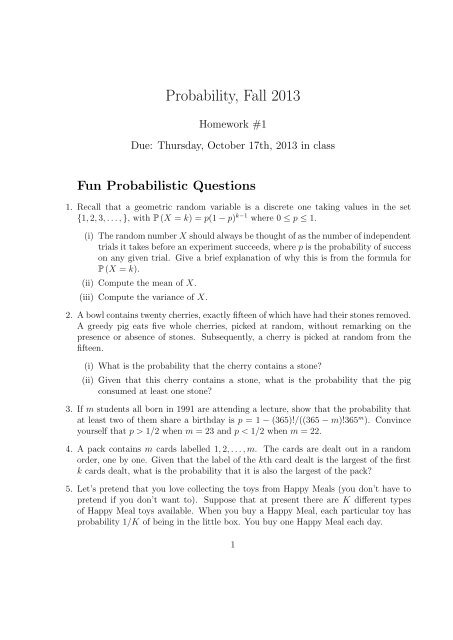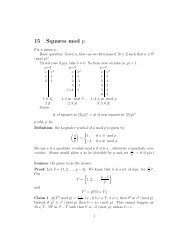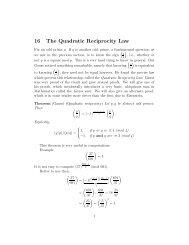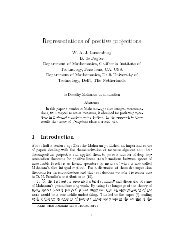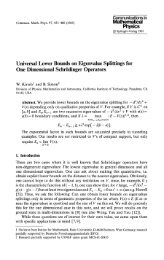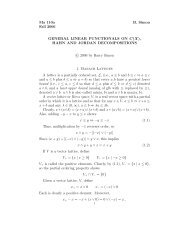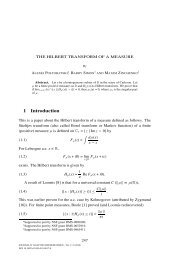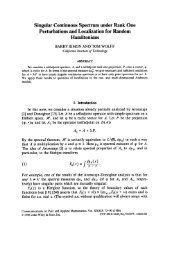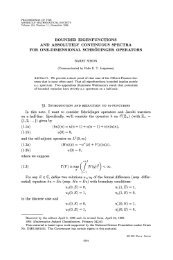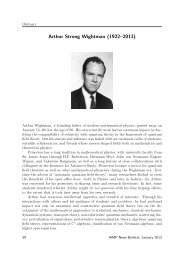Homework 1
Homework 1
Homework 1
You also want an ePaper? Increase the reach of your titles
YUMPU automatically turns print PDFs into web optimized ePapers that Google loves.
Probability, Fall 2013<br />
<strong>Homework</strong> #1<br />
Due: Thursday, October 17th, 2013 in class<br />
Fun Probabilistic Questions<br />
1. Recall that a geometric random variable is a discrete one taking values in the set<br />
{1, 2, 3, . . . , }, with P (X = k) = p(1 − p) k−1 where 0 ≤ p ≤ 1.<br />
(i) The random number X should always be thought of as the number of independent<br />
trials it takes before an experiment succeeds, where p is the probability of success<br />
on any given trial. Give a brief explanation of why this is from the formula for<br />
P (X = k).<br />
(ii) Compute the mean of X.<br />
(iii) Compute the variance of X.<br />
2. A bowl contains twenty cherries, exactly fifteen of which have had their stones removed.<br />
A greedy pig eats five whole cherries, picked at random, without remarking on the<br />
presence or absence of stones. Subsequently, a cherry is picked at random from the<br />
fifteen.<br />
(i) What is the probability that the cherry contains a stone?<br />
(ii) Given that this cherry contains a stone, what is the probability that the pig<br />
consumed at least one stone?<br />
3. If m students all born in 1991 are attending a lecture, show that the probability that<br />
at least two of them share a birthday is p = 1 − (365)!/((365 − m)!365 m ). Convince<br />
yourself that p > 1/2 when m = 23 and p < 1/2 when m = 22.<br />
4. A pack contains m cards labelled 1, 2, . . . , m. The cards are dealt out in a random<br />
order, one by one. Given that the label of the kth card dealt is the largest of the first<br />
k cards dealt, what is the probability that it is also the largest of the pack?<br />
5. Let’s pretend that you love collecting the toys from Happy Meals (you don’t have to<br />
pretend if you don’t want to). Suppose that at present there are K different types<br />
of Happy Meal toys available. When you buy a Happy Meal, each particular toy has<br />
probability 1/K of being in the little box. You buy one Happy Meal each day.<br />
1
(i) Find the mean number of days that elapse between the acquisition of the jth new<br />
toy and the (j + 1)st new toy.<br />
(ii) Find the mean number of days which elapse before you have a the full collection<br />
of toys.<br />
σ-Algebras and Random Variables<br />
6. Let Ω = {HHH, HHT, HT H, HT T, T HH, T HT, T T H, T T T }, let XY Z denote a<br />
generic element of Ω, and define the following random variables on Ω:<br />
A(XY Z) = 1, C 1 (XY Z) = 1 {X = H} , C 2 (XY Z) = 1 {Y = H} , C 3 (XY Z) = 1 {Z = H} .<br />
(i) What is σ(A)?<br />
(ii) What is σ(C 1 , C 2 )?<br />
(iii) What is σ(C 1 , C 2 , C 3 )?<br />
(iv) Is C 2 measurable with respect to σ(C 1 − C 2 + 2C 3 )?<br />
Probability Measures<br />
7. Let A and B be events with P(A) = 3/4 and P(B) = 1/3. Show that 1/12 ≤ P(A∩B) ≤<br />
1/3. Give examples to show that both bounds can be achieved.<br />
8. Let A n , n ≥ 1, be events such that P(A n ) = 1 for all n. Show that P(∩ ∞ n=1A n ) = 1.<br />
(HINT: Use the inequality P(∪A n ) ≤ ∑ P(A n ). This is sometimes called the “union<br />
bound”.)<br />
Distribution Functions<br />
Recall that any function F : R → [0, 1] is a distribution function if it is non-decreasing<br />
and<br />
lim F (x) = 1, lim F (x) = 0.<br />
x→∞ x→−∞<br />
For any distribution function F , there is always a random variable X with<br />
F (x) = P(X ≤ x).<br />
In fact you will see in Question 10 how to actually create, on the computer, a random<br />
variable X with a given distribution function F .
If there exists a function f(x) such that<br />
F (x) =<br />
∫ x<br />
then f is called the density function of F .<br />
−∞<br />
f(t) dt,<br />
9. For each of the following, indicate if it is a distribution function and if so give the<br />
corresponding density function.<br />
(i)<br />
(ii)<br />
F (x) =<br />
F (x) =<br />
(iii) F (x) = e x /(e x + e −x ) for x ∈ R<br />
(iv) F (x) = e −x2 + e x /(e x + e −x ) for x ∈ R<br />
{<br />
1 − e<br />
−x 2 , x ≥ 0<br />
0, x < 0<br />
{<br />
e −1/x , x > 0<br />
0, x ≤ 0<br />
10. Let X have distribution function<br />
⎧<br />
⎨ 0, x < 0<br />
P (X ≤ x) = x/2, 0 ≤ x ≤ 2<br />
⎩<br />
1, x ≥ 2<br />
and let Y = X 2 . Find<br />
(i) P (1/2 ≤ X ≤ 3/2)<br />
(ii) P (1 ≤ X < 2)<br />
(iii) P (Y ≤ X)<br />
(iv) P (X ≤ 2Y )<br />
(v) P (X + Y ≤ 3/4)<br />
(vi) the distribution function of Z = √ X.<br />
11. Suppose X has a continuous density f, with P(α ≤ X ≤ β) = 1 for some −∞ ≤ α <<br />
β ≤ ∞, and g is a function that is strictly increasing and differentiable on (α, β). Show<br />
that g(X) has the density function<br />
f(g −1 (y))<br />
g ′ (g −1 (y)) ,<br />
y ∈ (g(α), g(β)).
12. (i) Suppose X has a normal distribution with mean µ and variance σ 2 . Use the last<br />
exercise to compute the density of exp(X). (The answer is called the lognormal<br />
distribution, and is important in finance).<br />
(ii) Suppose X has a normal distribution with mean 0 and variance 1. Use the last<br />
exercise to compute the density of X 2 . (The answer is called the chi-squared<br />
distribution.)<br />
13. Show that if F (x) = P(X ≤ x) is continuous then Y = F (X) has a uniform distribution<br />
on (0, 1), that is P(Y ≤ y) = y for y ∈ (0, 1).<br />
This gives you an extremely useful method of simulating random variables on the<br />
computer. If you can compute F −1 , then you can ask the computer to generate a<br />
uniform random variable Y for you (all computers have a way of doing this, but the<br />
techniques behind it could take up an entire class), and then X = F −1 (Y ) will have F<br />
as its distribution function.<br />
14. If a distribution function is not continuous, it’s because there is at least one number<br />
x 0 (there may be more) such that<br />
lim F (x) =: F (x 0 +) > F (x 0 −) := lim F (x).<br />
x↓x 0 x↑x0<br />
Such numbers x 0 are called atoms of the distribution because there is a positive<br />
probability of the number being picked. In fact<br />
Convince yourself that<br />
P(X = x 0 ) = F (x 0 +) − F (x 0 −).<br />
(i) a distribution function with discontinuities does not have a density function,<br />
(ii) a distribution function can have at most countably many discontinuities.<br />
There’s no need to write anything for this problem, it’s for your own edification. Just<br />
make sure you think about it for a little bit.<br />
15. A distribution function can be continuous but still not have a density function. Such<br />
distributions are called singularly continuous, and are kind of wicked. Here’s a<br />
simple and classical example of how to construct one called the Cantor staircase:<br />
(i) Start by constructing the Cantor middle-thirds set. Let C 0 = [0, 1], and to<br />
construct C 1 remove the “middle-third interval” (1/3, 2/3) of C 0 . This leaves<br />
C 1 = [0, 1/3] ∪ [2/3, 1]. In general construct C n+1 from C n by removing the<br />
middle-third of each interval in C n . Draw a picture of C n for n = 0, 1, 2, 3. You<br />
see that the set gets sparser and sparser very quickly. In the limit though there<br />
is a non-empty set remaining, let’s call it C ∞ that is referred to as the Cantor<br />
middle-thirds set. Look it up on Wikipedia if you haven’t seen it before.
(ii) Now let f 0 , f 1 , f 2 , . . . be the uniform densities on C 0 , C 1 , C 2 , . . .. That is<br />
{<br />
Kn , x ∈ C<br />
f n (x) =<br />
n<br />
0, x ∉ C n<br />
where K n is some constant that doesn’t depend on x. What does K n have to be?<br />
(Hint: recall that the area under a density function must always be one).<br />
(iii) Now let F 0 , F 1 , F 2 , . . . be the distribution functions corresponding to f 0 , f 1 , f 2 , . . ..<br />
Give a quick sketch of F 0 , F 1 , F 2 , and F 3 .<br />
As n → ∞ the distribution functions F n get steeper and steeper on smaller and<br />
smaller sets. In the limit what you get is a distribution function F ∞ supported<br />
that is “infinitely steep” on a set of “Lebesgue measure zero”. Because the<br />
distribution function F ∞ is supported on the set C ∞ that has measure zero,<br />
it can’t possibly have a density function.<br />
This illustrates another important concept. Even though F ∞ is the limit of the<br />
distribution functions F n , which all have densities, F ∞ itself does not have a<br />
density.


